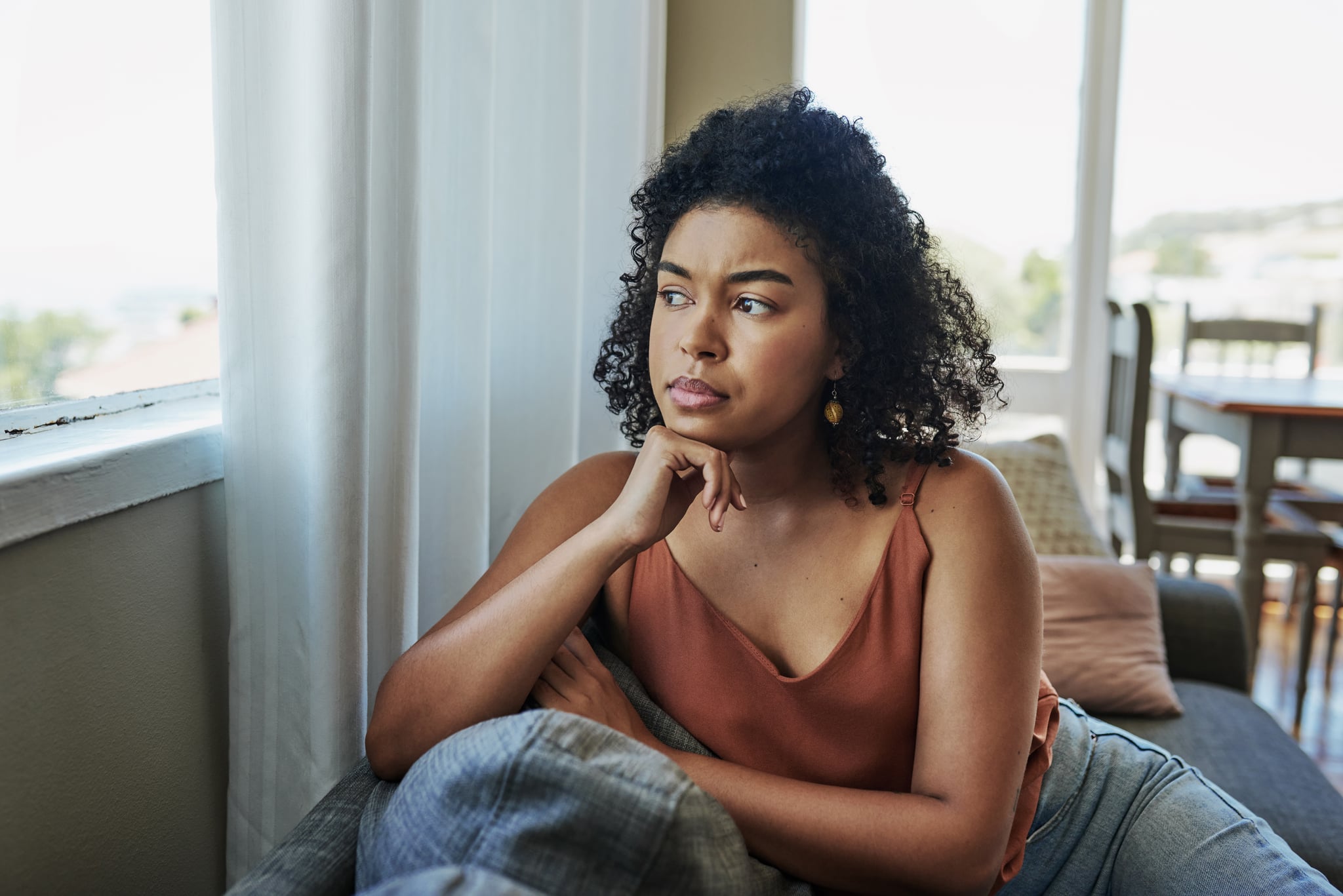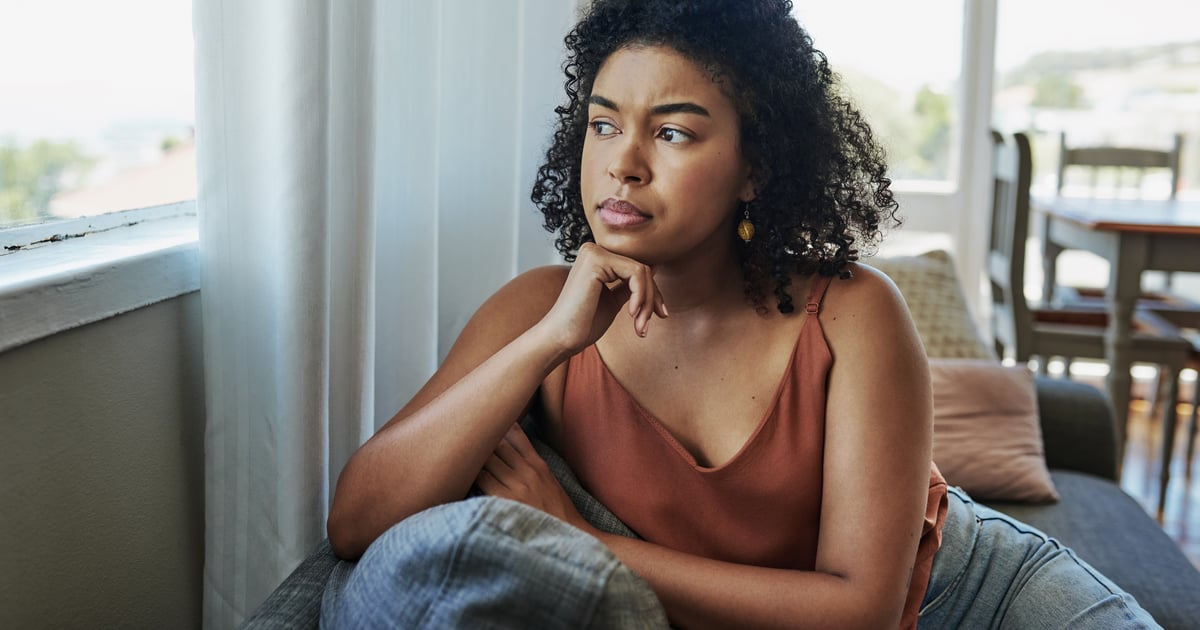Products You May Like

Picture this: you’re about to head out to a dinner date with your significant other, and they text you about a change in plans. Their parents came for a surprise visit, and you’re going to meet them for the first time. You freeze up. The thought of them staring at you, grilling you question after question, and feeling put on the spot — it’s all just too much. You retreat to your bed and tell your significant other that you’re suddenly not feeling well and can’t go. This is an example of retreating into what’s called an anxiety cave.
If you’re not familiar with the term, an anxiety cave is a phrase used to describe retreat and isolation from social connections, work, and the world when you’re experiencing heightened anxiety, explains therapist and licensed ACA counselor Anna Papaioannou, who specializes in anxiety. It is a “period of disappearing or falling off the face of the earth from interacting with others and retreating to the false safety of isolation,” explains Papaioannou. This is a common occurrence for many who experience anxiety, as you may become easily overwhelmed by external stimuli, or fear the unknown or uncontrollable, explains Papaioannou. The location of your anxiety cave could be anywhere you feel safe. This may be your own home or somewhere familiar to you. An anxiety cave often takes place in a space where you spend the majority of your time. If you think you’ve been stuck in an anxiety cave before, here’s what you need to know about the mental health phenomenon and how to get out.
What Triggers an Anxiety Cave?
Obviously anxiety — but specifically a heightened sense of anxiety. Typically someone will experience intense physical or mental symptoms of anxiety before retreating into an anxiety cave. Some people may experience only physical symptoms and no mental symptoms, or visa versa. Some people may experience many symptoms, and some may experience only one symptom. “All are valid and real,” Papaioannou says.
Physical symptoms of anxiety include:
- Increased heart rate and respiration and/or chest tightness
- Hot or cold flushes or sweating
- Trembling or shaking, or a tingling sensation
- Dizziness, weakness, or fatigue
- Stomach distress such as constipation, diarrhea, stomach cramps, or nausea; needing to go to the toilet more or less often
- Headaches
- Insomnia or sleep disturbances
- Muscle tension and/or pain
- Feeling restless or unable to sit still; leg shaking or toe tapping
- Teeth grinding
- Changes in appetite
- Changes in sex drive
- Panic attacks
- Biting inside of mouth, lips, or nails
Mental symptoms of anxiety include:
- Feeling tense, nervous, or unable to relax
- Having a sense of dread; worrying that you’re losing touch with reality
- Fearing the worst case scenario; worrying a lot about things that might happen in the future
- Feeling like the world is speeding up or slowing down
- Heightened self-consciousness; feeling like others notice you’re anxious and are looking at or judging you
- Feeling like you can’t stop worrying or that bad things will happen if you stop worrying
- Worrying about anxiety itself, for example worrying a panic attack might happen
- Seeking reassurance from others or worrying others might be angry or upset with you
- Low mood and depression
- Rumination: thinking a lot about bad experiences or thinking over a situation again and again
- Depersonalization: a type of dissociation where you detach from your mind or body, or like you’re a character in a film
- Derealization: another type of dissociation where you feel disconnected from the world around you, or like the world isn’t real
Is an Anxiety Cave the Same as Cave Syndrome?
Cave syndrome is slightly different than an anxiety cave. The term cave syndrome was coined in 2021 by psychiatrist Arthur Bergman due to the COVID pandemic. It describes the feeling of fear or reluctance to return to public life after isolation and sheltering in place. The pandemic created a lot of anxiety due to the risk of illness and death. And even though vaccinations are available and proven to help, and mask mandates are lifting in many places, certain people may still have a hard time releasing that worry. The term anxiety cave used by Papioannou describes the feeling of not wanting to leave your house or safe space because you’re feeling anxious about something, COVID related or not. She began using the term over 13 years ago to describe her own experience with anxiety and depression. She also said that many of her clients refer to themselves “coming out of a cave” after dealing with an episode of heightened anxiety. Both an anxiety cave and cave syndrome are connected to a fear of returning to public life, and both can keep a person isolated.
How Long Does an Anxiety Cave Last?
When someone is experiencing anxiety, they can get caught in thought spirals and what-if scenarios that can overwhelm the nervous system and cause a freeze or shutdown response, making it difficult to leave their anxiety cave. Depending on access to internal resources like therapy or a support network, and emotional regulation tools (think: deep breathing, butterfly tapping, or ice cubes to cope with strong emotions), someone’s stay in an anxiety cave could last a few hours, several days, weeks, or even months. If the individual doesn’t have the support network they need, or they feel they’re incapable of handling the challenges that await them, Papaioannou says it can be much more difficult to emerge from their anxiety cave.
Are There Any Benefits to Anxiety Caves?
Everyone has their own unique set of coping mechanisms and survival resources that they lean on when feeling anxious or unsafe, Papaioannou says. Retreating or isolation can be a valuable resource when you need some space to down regulate your emotions or to process challenges.
However, isolation or avoidance in the long term further exacerbates anxiety and the notion that you cannot handle or face difficult situations, she warns. If you’re feeling stuck and exhausted to the point where you are consistently unable to leave your room or house, or are neglecting basic self-care and hygiene, consider reaching out to a therapist to help you work through it.
How Do You Overcome an Anxiety Cave?
At its core, anxiety is a survival response designed to keep you safe. Your nervous system and brain are constantly listening to and monitoring both your environment and internal world to check for safety, she explains. If it detects any signs of danger or dysfunction, this can trigger the fight or flight response and feelings of anxiety and panic. Try these three somatic techniques to regulate your nervous system, recommends Papaioannou. They can support you feeling grounded and safe in your body during stressful or anxious moments and help you come out of your cave:
- Tap into and notice your current physical state: Noticing and connecting to sensations is important to build body awareness and bring you back to your present situation rather than the what ifs. Body awareness means being consciously connected as a whole being versus mind and body being separate, explains Papaioannou. Start by sitting in a chair, take a moment and notice your overall experience. Move your feet on the floor, shifting until you feel fully connected to the floor. Now feel your back and bottom on the chair, noticing how the chair supports you. Adjust until you feel your comfort spot. You should start to feel more grounded. Take a few moments to really enjoy the comfort of being supported by the chair and stabilized by the floor. What do you notice now about your overall comfort, physically and emotionally? Increasing your connection to the sensations or experience that your body is having builds a pathway for changes in response to overwhelming feelings.
- Exercise containment with safe touch: This technique helps you reclaim safety within your body. Take your right hand and place it just below your left armpit, holding the side of your chest. Crossing your arms, place your left hand on your right bicep (or shoulder or elbow). Take several minutes to notice the feeling under your hands. Does your body feel warm? Is the fabric of your shirt smooth or scratchy? Can you feel your heartbeat? Do you experience a sense of containment from your hands and arms? Is it pleasant? As mentioned above, this will bring about body awareness, connect your mind and body, and help overcome overwhelming thoughts and sensations.
- Make the VOO sound: Think of the sound of a foghorn makes. Take a deep breath, then imitate the foghorn, making a sound that rumbles through your torso. See if you can feel the vibrations of the sound all the way down to your pelvic floor. Note that this doesn’t necessarily mean you have to be loud when you make the sound. The key is to make the pitch of the sound as low as you possibly can. As you run out of breath on the Voo, let the next breath come in naturally. The Voo sound activates the vagus nerve through vocal toning, Papaioannou says. It also lengthens your exhale which activates the parasympathetic nervous system. The Voo sound helps you move from focusing on the obsessive thoughts in your mind to the physical sensations of your body. If you make the sound and feel your mind and body calming down, stay with that and enjoy it. Then, feel free to make the sound again. If you feel your mind and body are becoming more triggered, (which the Voo can produce for some people, even if they’ve found the exercise calming before), let go of this exercise for now and use another one listed to settle your system. The Voo sound isn’t recommended more than three times in one sitting, Papaioannou says.
Remember: you can use one or all of these somatic tools to feel more grounded, regulate your nervous system, or reclaim a sense of safety in your body. But anxiety is not something that you have to deal with or manage on your own. Having a support network such as a friend or family member that you can reach out to can help you to feel seen, heard, and supported. Knowing that your feelings are real and valid allows you to feel less isolated in your experiences.
If you notice that quick tips like the ones mentioned above haven’t been working, and that your friend or family member isn’t able to offer you the support you need, consider seeing a professional for help, Papaioannou suggests; especially if your experience of anxiety is interfering with routine activities and causing physical symptoms. A mental health professional can help with streamlining the process of identifying your triggers and maintaining long-term strategies.
Image Source: Getty / LaylaBird
